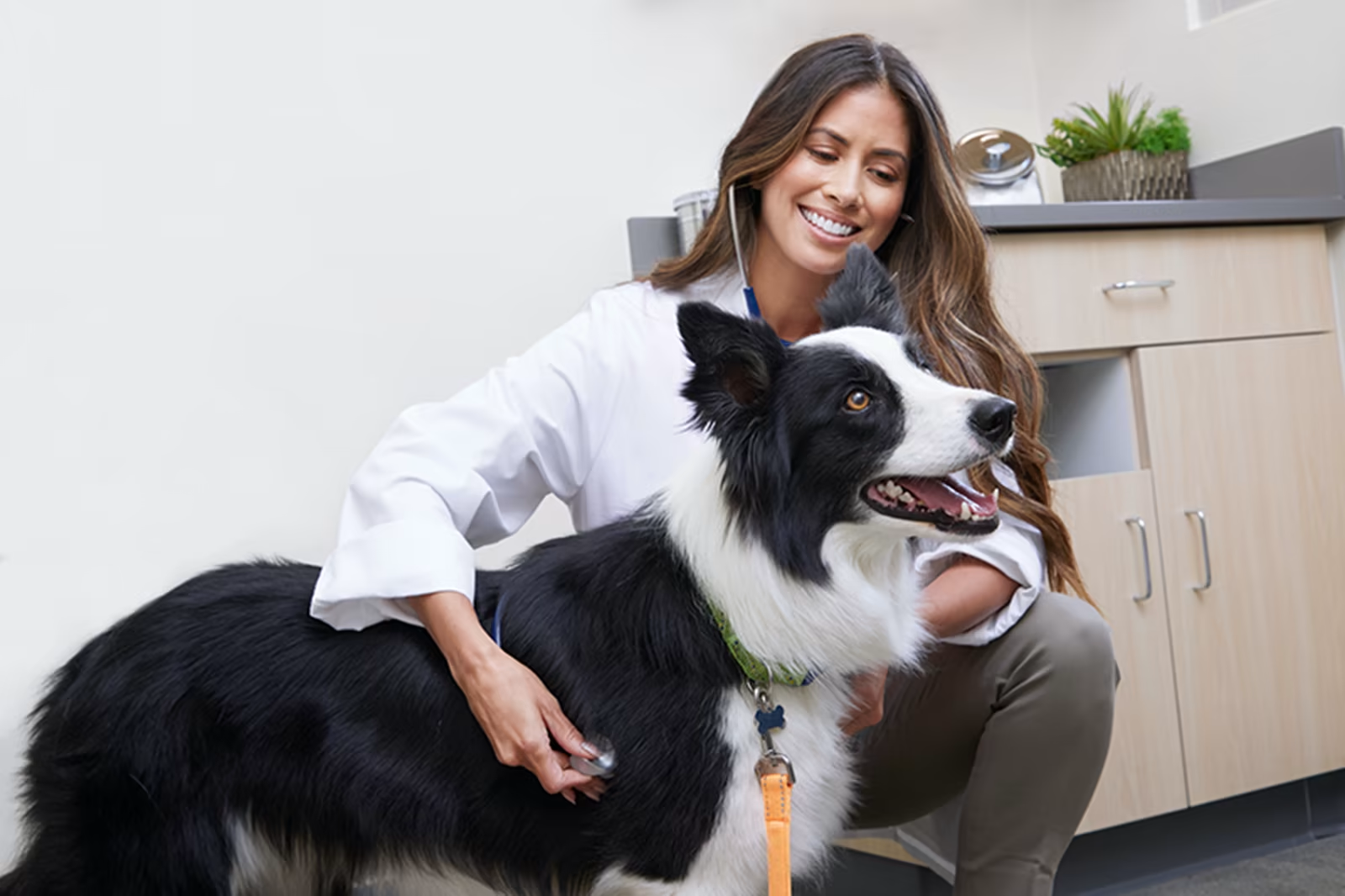Table of Contents
Why is microchipping important?
One in three pets will become lost at some point in their lives, according to the American Veterinary Medical Association (AVMA). One of the best ways to help ensure that you and your dog or cat will be reunited if they get lost is to make sure they have a microchip.
What is a pet microchip, and where is it inserted?
A microchip is a tiny transponder (about the size of a grain of rice) that is implanted subcutaneously (under your pet’s skin) between their shoulder blades. The transponder contains a unique identification number to your dog or cat that when scanned with a microchip reader it displays the ID number. This ID number is stored with the company and connects with your contact information. The beauty of a microchip is that it doesn’t need batteries and doesn’t use an electric charge. The microchip is designed to last for up to 25 years, so you shouldn’t need to replace it. One of your most important jobs as a pet parent is to register your dog or cat’s microchip ID number and assure your contact information is up to date, so you can be contacted if your lost pet is found.

How to get your dog or cat microchipped
First, make an appointment with Petco’s veterinary services. veterinary team will scan your pet and--if they find a microchip--they’ll give you your pet’s ID number and the name of the microchip registry. You can call the registration company and provide updated contact information.
Microchipping procedure & registry
If your dog or cat doesn’t have a microchip, our vets can place one. A microchip is implanted using a needle. The microchip is so small that implantation does not require surgery or even anesthesia. Your Petco vet will provide you with paperwork containing your pet’s ID number and registry information to register your pet.
Microchipping is not a GPS–but it can save your pet’s life
A microchip is not a GPS tracker that tells you where to find your pet if they get lost. A GPS microchip would need to be constantly powered, and that would make it hard to maintain. Let’s say your pet goes exploring without your permission. Maybe their collar gets snagged and comes off, so they no longer have their collar with ID. If your pet is found and brought to a local shelter or vet's office, they are scanned for a microchip. The scan reveals your pet's identification number and its associated registry. The vet or shelter contacts the registry, who reaches out to you to tell you where to find your pet. It is so crucial that you register and maintain an accurate contact associated with your pet’s microchip. The chip itself only transmits an ID number. It’s up to you to connect that ID number to your personal information so the registry can reach you if your pet gets lost.

Lower the risk of losing a pet
The best way to reunite with your pet is to prevent them from getting lost in the first place. Collars, ID tags and microchips can be very useful if this should happen. You can also help lower your risk of your pet going missing with securing pet doors, electronic dog fences and behavioral training for your dog. At Petco, we are here to help you keep your pet safe and sound. Keep reading to learn more about why it’s important to microchip your pet or find out more about pet behavior training. Petco Love Lost was created to help missing pets be reunited with their pet parents. Upload your pet's photo to their database and explore their site for additional resources.
Frequently Asked Questions
The answer is a resounding yes, as long as your pet’s ID number is registered. In fact, according to the American Veterinary Medical Association (AMVA), microchipped dogs are twice as likely to return home to their pet parents than pups without microchips. And microchipped cats are 20 times more likely to be reunited with their family than their unmicrochipped counterparts.
Unfortunately, nearly 40% of cats and dogs with microchips aren’t registered. In fact, incorrect or missing pet parent information in the microchip registry is the main reason lost pets don't make it home.
Several different registries offer pet microchips, and each registry keeps its own database. Most registries charge a small upfront cost for a lifetime membership.
Some shelters will microchip all the pets they place and include the registration cost in the pet’s adoption fee. In those cases, the paperwork you'll receive as part of your adoption should include the information on your pet’s microchip, including the microchip ID number and the microchip’s registry.
The day you bring home your new dog or cat is an exciting one, but don't get so caught up in the fun that you forget to update their microchip. You can either call the registry to submit your information or create an account on the registry’s website. It only takes a few minutes to help ensure your pet makes it back home if they ever get lost. If your pet isn't microchipped before they become yours, it will be up to you to take care of that important procedure.
Fortunately, although different microchips transmit their information on different radio frequencies, most shelters, vet offices and animal control offices possess scanners that can read any type of microchip. And Petco’s veterinary services are here to help you get registered or get microchipped.
Yes. Collars can get loose and come off when a pet gets lost, especially if they wear a breakaway collar. Additionally, the engraving on ID tags can wear down over time, making it difficult for anyone to read them. Microchips and a collar with an ID tag are not mutually exclusive—your pet needs both.
The microchip is extremely small, about the size of a grain of rice. Some pets may feel a little pain when it's implanted. Anesthesia is not needed, but you can ask your vet to apply a numbing agent. Your pet can go home with you and engage in everyday activities immediately after the procedure. Keep in mind that they may feel temporarily sore at the injection site.
Whenever your contact information changes, be sure to update your pet’s microchip information. Call the microchip registry or sign into your online registry account to update your information. Our vet’s office can help you with this step.
If you think your pet may already have a microchip from a previous pet parent, ask one of our Petco vets to scan for the microchip. The vet can give you the microchip’s ID number and registry information. You’ll then need to contact the registry to change your pet’s contact information.
In many cases, a pet will need to have a microchip to travel to another country. Before traveling with a pet, review your destination country’s rules about microchipping, vaccinations and quarantine periods. Even if a microchip is not required for travel, it is still highly recommended for proper identification and tracking purposes.
Within 24 hours of being microchipped, your pet’s tissue will bond to the chip, which usually prevents it from moving around. In rare cases the chip may migrate under the skin, but it will not fall out.
Microchips are detected using scanners that emit radio waves of certain frequencies that activate and identify the microchip. The most common scanners in the US emit 125, 128 and 134.2kHz. If the implanted microchip is only read by a specific scanner, this can cause confusion for pet parents. At Petco, we always utilize the ISO microchip (134.2mHz) which is recognized nationally and internationally. This is important especially when travelling with your pet or if your pet is lost as the ISO microchip is more widely recognized and used in patients.
There is no maintenance needed for your pet’s microchip. But it is important for you to maintain your microchip ID number and registry. Your contact information should stay current with the registry so you can be contacted if your pet is lost.
You can learn more about how to care for your pet with Petco’s Animal Care Sheets.
Cat Cameras for Home
Smart Pet Devices
Pet Collar Tags
Pet Smart Home Electronics
Small Pet Trackers
Pet Car Solutions
Pet Organization Solutions
Pet Health Solutions
Pet Friendly Pest Control
Personalized ID Tags for Pets
Pet Medical Supplies
Dog Shelters for Outside
Pet Security
Licensed Pet Gear
Home Protection Devices for Pets
Pet Cuddler
Affordable Pet Supplies
Pet Monitoring For Work
Nail Cap Refills for Pets
Pet Magnets
I'm thinking of getting my puppy neutered but were would you recommend it I love in Albuquerque NM
How much does it cost for a rabie shot for a cat
I was just wondering about your vaccine clinics and also would the vet that is there be able to fill out a form for where I live
Took in a dog who has been mistreated...want to make sure he's vaccinated and fixed also finding out his breed and estimated age
I took my kitten to a Vetco Wellness clinic today (3954 Sports Arena Blvd) because she has diarrhea, and was told that they only do vaccinations. The Vetco website is giving out the wrong information, and I wasted 1/4 tank of gas on that trip. Please update the information on the Vetco website to reflect what they actually do.
Is the rabies vaccine, one of the vaccines that is offered at petco's vaccine clinics?
My dog has a big skin tag that keeps getting bigger. Is there anything I can do at home to get rid of it or should I go to a vet and have them take it off? They told me it would cost more money to put him to sleep then the procedure. i can not get my pics to upload
What shots dose my puppy need
I rescued some kittens that are approximately 12 weeks old, 2 males - 3.4 and 3.9 pounds. I want to visit the Vetco shot clinic as I am going to keep them. would really appreciate a recommend shot schedule for them since they are starting late. Thank you
My cocker spaniel has a small cyst the size of q tip like growth right in front of his ear he rubs all time I can't afford surgery what can I do at home to help it took him to vet said it would get bigger an bigger help please can't get photo at this minute will if needed asap
Hello, we adopted an 8 year old dog. He hasn't had any shots for the past 3-4 years. What shots is he due to have? Thank you!
What do the Bordetella & Caninne Flu vx cost?

